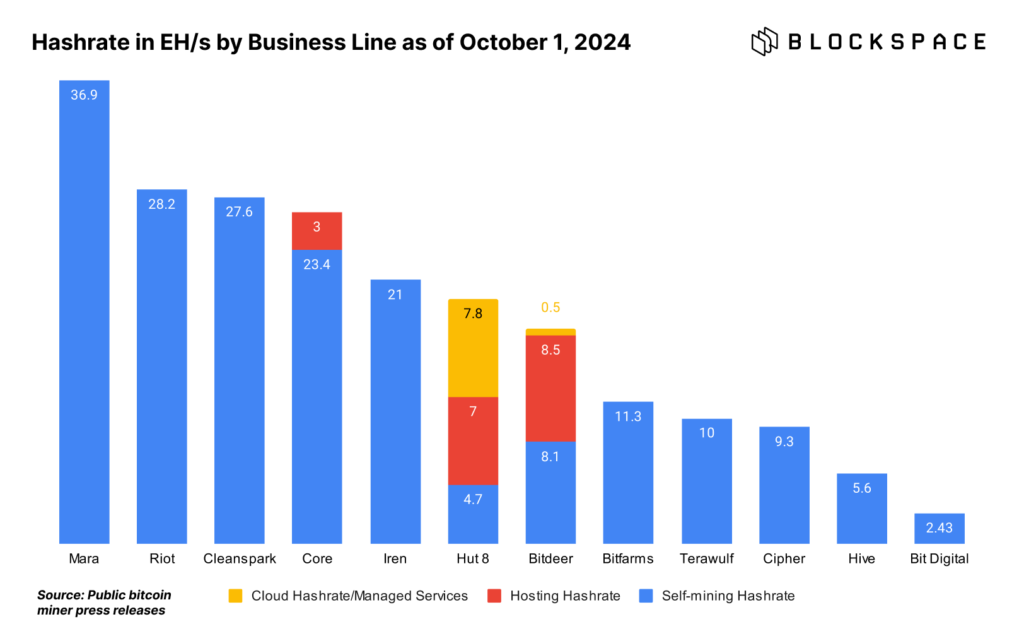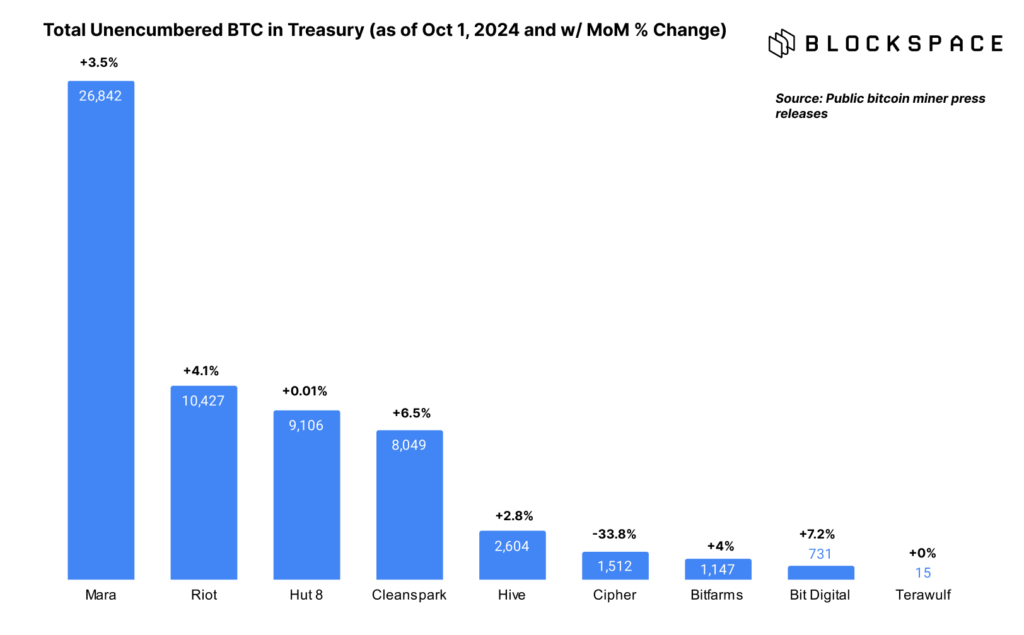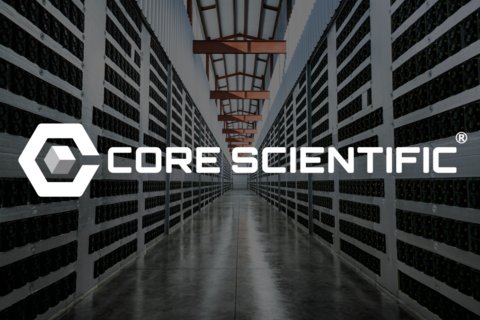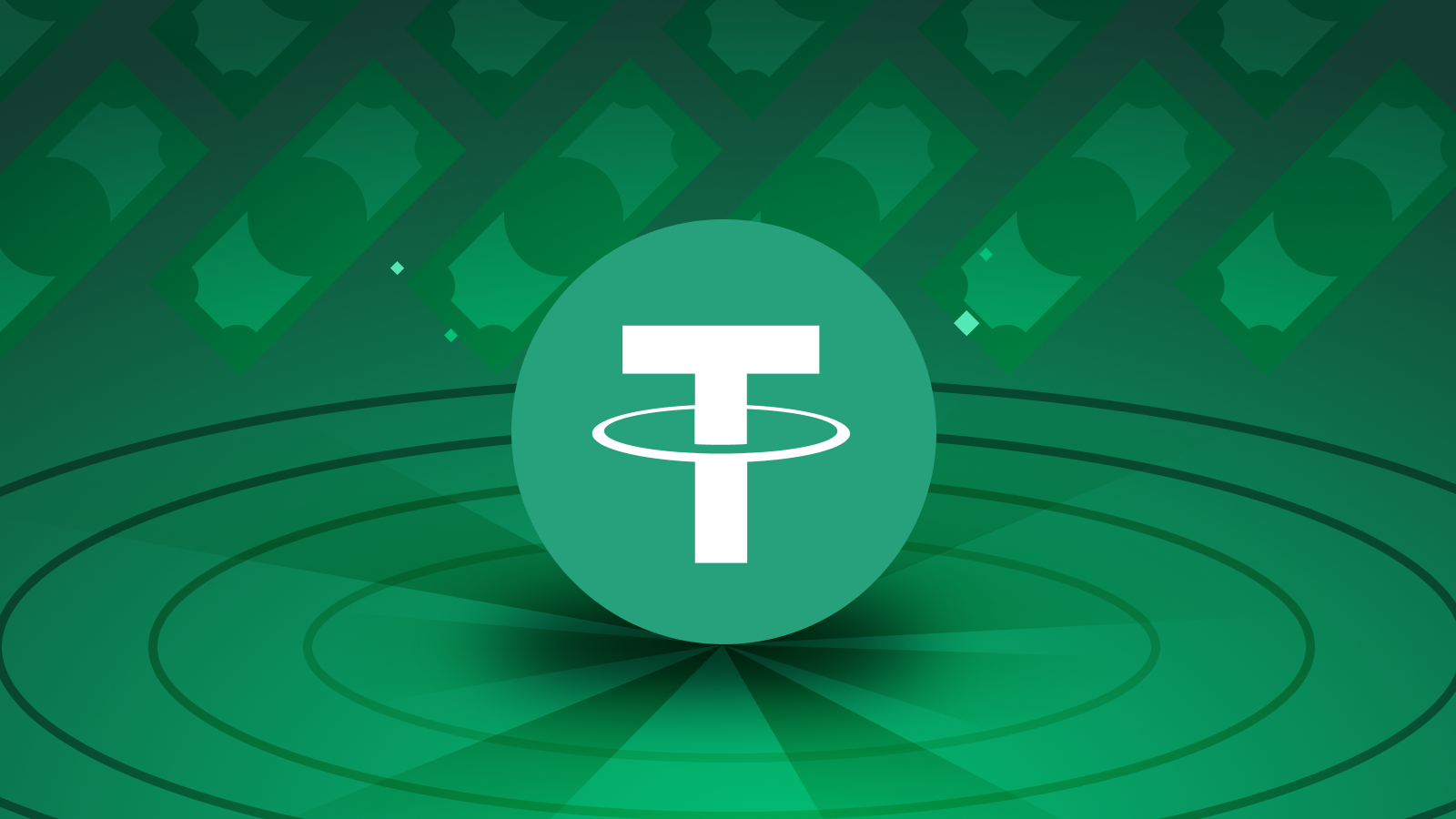Publicly traded bitcoin miners are still adapting to the new post-halving normal, but even as they confront a new market environment, the playbook – expand and improve energy efficiency to stay ahead in the hashrace – is the same as always.
So in September as with other months, we saw more of the same from public miners, including the usual chest beating about expansion plans and end-of-year hashrate targets (which always seem spectacularly quixotic, but I digress…). That said, outside of the usual focus on growing hashrate, two terms seemed to define September’s round of public miner updates: liquidation and AI.
If you’re tired of seeing or hearing “AI” and “bitcoin mining” in the same sentence, sorry friend, but you best glue your eyelids shut or gum up your ears, because that’s all that public miners – and equity markets broadly – want to talk about these days. And more miners are talking about entering the AI game now than ever before.
Miners also sold more bitcoin in September than August, and some miners made these liquidations to whet their incipient AI businesses.
Public miners grow their hashrate in September 2024 (but what’s new?)
Before we touch on AI strategies and bitcoin liquidations, let’s touch on the requisite hashrate tally from the miners in our update.
Nearly every miner grew their self-mining hashrate from August to September, with the exception of Bitdeer, which decreased its self-mining hashrate by 6%, and Hut 8, Bit Digital, Bitfarms, and Terawulf, all of which did not increase or decrease their self-mining hashrate over September.

If we take a look at hashrate by business line, we can see that the hosting market is in a bit of flux. Core Scientific, for instance, reduced its hosted hashrate from 4.9 EH/s to 3 EH/s over September, while Hut 8’s hosted hashrate stayed stagnant at 7 EH/s and Bitdeer’s rose from 8.2 EH/s to 8.5 EH/s. Bitdeer’s cloud mining business continues to dwindle, falling from 0.8 EH/s to 0.5 EH/s from August to September. The reduction in hosting and cloud deals raises some salient questions: Are hosting contracts being cut in favor of other business lines? Or are hosted miners failing to pay up with hashprice so low?
Finally, let’s look at how these miners have fared with their hashrate expansion in Q3 versus Q2. Q3 marked the first full quarter in the new 3.125 BTC block reward era, and most every miner responded accordingly by stacking new hashrate under management. The only miner that backslid over Q3 was Bit Digital.

Public bitcoin miners sell more than 2,000 BTC in September
Treasury management has become more crucial than ever for public bitcoin miners now that margins are thin. Appropriately, the public miners in our update continue to liquidate bitcoin to source cash for operations and expansion, and they sold more bitcoin collectively in September (2,267.5 BTC) than August (1,464.9 BTC).

The biggest outlier in the chart is Cipher, which sold 923 BTC in September (~$55.7 million worth assuming September’s average bitcoin price of $60,358). Cipher used proceeds from this sale to fund its acquisition of the 300 MW Barber Lake site, which we will touch on more in the section below.
Core Scientific sold the second most bitcoin in September – not surprising given that Core Scientific is focusing on an aggressive expansion into AI/HPC and focused on reducing its still hefty debt load of $318 million.
Almost every public bitcoin miner that holds bitcoin grew their BTC treasury last month, with the exception of Cipher and Terawulf.

More public miners enter the AI race
With each passing month, public bitcoin miners are presenting more mature AI/HPC strategies, and more bitcoin miners are entering the AI fray. The usual suspects – Core Scientific, Bit Digital, IREN, Hive, and Hut 8 – provided updates on their AI business lines in September, while a number of newcomers advertised their early moves into the AI market.
Bitdeer: A project management consulting firm, TLM Group, appraised Bitdeer’s Massillon and Clarington/Hannibal sites in Ohio for AI/HPC capabilities, deeming them fit for tier 3 data center construction; Bitdeer is now in talks with developers for these sites and potential AI/HPC compute clients. TLM Group is currently assessing other Bitdeer sites around the globe as well. In its September update, Bitdeer stated that its active AI cloud services were at close to 100% utilization over the month (Bitdeer has yet to report AI revenue of any kind in its quarterly filings or monthly updates). Bitdeer also reported that it launched a pilot of H100 Nvidia computers in Canada.
Bit Digital: Bit Digital did not provide any substantial updates for its AI business in September, but it did report a revenue of $4.2 million for the month from 256 active AI servers.
Cipher: Cipher does not currently have an active AI/HPC business line, but the company did acquire Barber Lake, a 300 MW site in West Texas, for $67.5 million. Per a Cipher press release, the site includes “a newly constructed, fully energized, high-to-mid voltage substation, and all necessary regulatory approvals.” Cipher did not explicitly state that it will use the site for AI, but it did say that Barber Lake “is ideally suited for either hosting a large HPC customer or mining bitcoin.”
Core Scientific: In its September update, Core Scientific – a frontrunner in the bitcoin miner AI race given its multi-year, multi-billion contract with CoreWeave – provided the most detail yet regarding where it plans to erect its AI data centers. To support its AI business, CEO Adam Sullivan said that the company is currently building a substation for its 100 MW Muskogee, Oklahoma site, which is under development; additionally, he said that Core Scientific is on schedule to finalize its 100 MW expansion at its Pecos, TX site.
Hut 8: At the end of September, Hut 8 announced its GPU-as-a-service business line. Hut 8 is hosting the initial deployment of 1,000 Nvidia H100 GPUs at a tier-three data center in Chicago under a five-year contract.
IREN: In September, IREN purchased 1,080 Nvidia H200 GPUs, which it plans to receive and deploy in Q4 2024, expanding its total GPU fleet to 1,896. IREN’s contract with its largest HPC client, poolside, lapsed at the end of August, but the company said that it has closed 7 deals with new, undisclosed clients since the Poolside contract expired. IREN reported $680,000 in AI revenue for September.
Terawulf: Terawulf is developing 20 MW of AI/HPC capacity at its Lake Mariner site in a facility dubbed CB-1. Prior to this, Terawulf reported that it completed a 2 MW pilot as a proof-of-concept for its AI business line.
Notable updates for public bitcoin miners in September
Now to get back to the bread and butter of these miners, we’ve rolled up the most important updates related to each company’s mining business below.
Bitdeer: The most consequential and notable update from Bitdeer last month came from its burgeoning ASIC manufacturing business line. The company reported that the first version of the ASIC, the SEALMINER A1, is on schedule for delivery in Q4 2024, and Bitdeer expects this will added 3.4 EH/s to its proprietary hashrate. Bitdeer also received its first tape-out from TSMC for its SEALMINER A2, which it plans to mass produce in November 2024, and it’s expecting a tape-out for its SEALMINER A3 in Q4 2024. Bitdeer claims that the efficiency ratings for the ASIC chips that will go into the SEALMINER A2 and SEALMINER A3 are 13 J/TH and 10 J/TH, respectively.
Bitfarms: Bitfarms entered into a hosting agreement with Stronghold Digital for 10,000 Antminer T21 ASIC miners, which Bitfarms originally planned to install at its Yguazu site in December. The company anticipates it will energize the units in October, which will add 2.2 EH/s to Bitfarm’s hashrate, and the contract will run through December 31, 2025. Bitfarms announced in August that it would be acquiring Stronghold.
Cipher: Cipher spent September prepping its Odessa facility for the S21 and A1466 ASIC miners that the company purchased last year, and it expects to finalize the upgrade to these new models by the end of the year. Cipher CEO Tyler Page also commented that development on its new site, Black Pearl, “is progressing well and is on track for energization by the end of Q2 2025.”
Cleanspark: Cleanspark had a laundry list of updates for its numerous mining sites in September. To start, Cleanspark purchased two turnkey sites in Mississippi, across which it plans to outfit with 1 EH/s of S21s by the end of December of this year; it also finalized the acquisition of its second mining site in Wyoming; and it also closed on five of the seven sites in Tennessee that it agreed to acquire in September (Cleanspark expects to close on the remaining two this month, and the sites should collectively add 5 EH/s to the company’s fleet). In Georgia, Cleanspark added 15 MW and 50 MW of capacity to its sites in Dalton and Sandersville, respectively. Finally, the company expects to close its acquisition of GRIID by the end of October, and it decided against renewing its contract with Cormint to host miners at Cormint’s Massena, NY facility (the current hosting contract expires on January 1, 2025).
Hive: Hive CEO Aydin Kilic said in the company’s September update that it plans to cycle out older models for the S21 Pro over the next six months.
Hut 8: The biggest news for Hut 8 last month came in the form of a partnership with Bitmain. The company worked with Bitmain to design its latest hydro model, the Antminer U3S21EXPH. Per the partnership, Hut 8 plans to host 15 EH/s of the unit for Bitmain in its Vega, TX site, with full energization expected in the first half of 2025. Hut 8 has the option to purchase the hosted deployment in three tranches within six months of each installment.
IREN: IREN received its first orders of the S21 XP orders in September, with more to come in October and November. The company is targeting 31 EH/s by the end of the year.
MARA: Ever the company to make big promises, MARA stated in its September update that it is on pace to hit 50 EH/s by the end of the year. To this end, the company is converting its air-cooled Granbury facility into an immersion facility, which it anticipates will be completed by the end of the year.
Riot: In September, Riot completed its third 100 MW building (Building B1) in its Corsicana facility, bringing the new site’s total capacity to 300 MW. Riot is working on its 100 MW Building B2, the last building in its first phase of development for Corsicana, and it expects to complete it in November.
Terawulf: In September, Terawulf exited its joint-venture with Talen Energy by selling its 25% stake in the Nautilus facility for $92 million. “The $92 million consideration consists of $85 million in cash and approximately 30,000 Talen-contributed miners and related equipment valued at around $7 million,” according to a press release. Terawulf plans to roll the profits from the sale into its Lake Mariner facility, with a target of reaching or exceeding 13 EH/s by Q1 2025.




